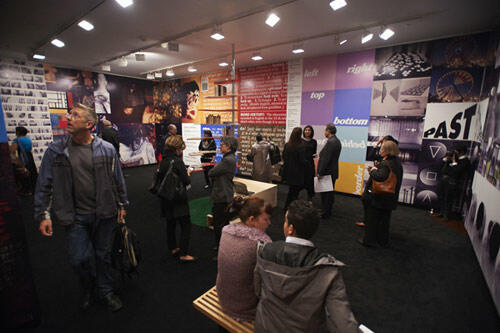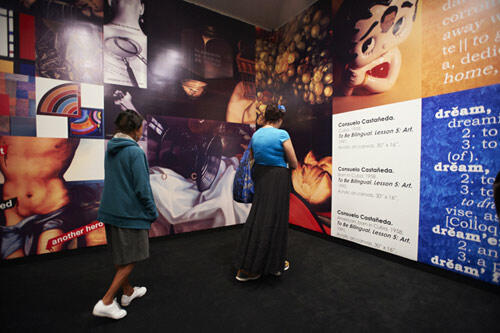Consuelo Castañeda: For Rent
Americas Society, New York
The feeling of uprootedness and of not belonging is one of the most problematic experiences émigrés must confront in the perennial ordeal that the loss of the place of birth and the adaptation to the country that takes them in entails. In this perpetual exercise of splitting of the ego, the body becomes the only habitable physical sanctuary. The rest, always transient, is something that we borrow and that does not belong to us, after all.

Consuelo Castañeda's excellent proposal in For Rent was based on this notion of borrowing that has obsessed the artist from the beginning of her artistic career and that finds a new connotation in the migratory act. A brief inventory of some of the titles of her solo shows − Finding the Self (Art @ Work, 2008), To be Bilingual (Fred Snitzer, 1995) and now For Rent (Americas Society, 2011) − suffices to bear witness to her interest in inquiring into the decentralization of the ego.
In For Rent, the artist appropriated her personal experience, establishing a parallel between her own history and that of the building that now hosts the Americas Society and was formerly the headquarters of the Soviet Mission to the United Nations during the Cold War period. Thus, the building becomes an existential parable about difference and tolerance, the I and the Other, East and West, at a moment when the acceptance of immigrants on American soil is a debate issue. With this central idea as her point of departure, Castañeda transformed the building into a colossal installation that comprised three main environments. In the first of these −Guantanamera − she appropriated the homonymous documentary film by Ross Birrell and David Harding. The documentary, produced after Fidel Castroís resignation in 2009, and shot in Havana and Miami, utilizes the best known of Cuban songs, the Guantanamera, whose lyrics are verses by the Cuban poet and martyr, José Martí. The parallel twoscreen, two-channel projection of the documentary effectively illustrated the sense of counterpoint of a split identity. Two diverging voices, two points of view, two destinies paradoxically intoning in unison that sort of Cuban unofficial anthem, confronted one another as in a cockfight.
In a second gallery, Castañeda featured an intervention of one of Gego's (Gertrude Goldschmidt) most emblematic works, the Reticulárea, the epigone of Venezuelan Modern Art. The intervention of this work, created for the Americas Society in 1969, established an interesting parallel and a tribute to the German artist of Jewish origin, whose nationality was revoked in 1935 after the Nazi rise to power. The flexible structure conveying messages of adaptation and free-spiritedness introduced the spectator in an exalted cosmogony.
The last gallery, in turn, hosted a retrospective of Castañeda's copious and varied production, which included painting,photography, installation, collage, and graphic design, among other media. Taking advantage of the work with wallpaper that the artist had previously explored, the walls of the exhibition hall were covered with an impressive collage that filled the entire room in the manner of a visual chronology spanning more than four decades of creation.
It was pleasant to revisit works such as Boticcelli, Hokusai y los tiburones (Boticcelli, Hokusai and the Sharks) (1986) Tiziano-Barbara Kruger (1987), Una historia contada en 70 páginas (A story told in 70 pages) (1988) or Lichtenstein y Los Griegos (Lichtenstein and the Greek) (1989), crucial pieces that marked the new vigor of the art scene of the 1980s in Cuba, and that attested to the predilection for appropriation and
pastiche that distinguish this creator.
The early interest in historical research in Castañeda's oeuvre is related to the fact that in Cuba, as a consequence of the conditions prevailing in a society closed to the world until the fall of Eastern Europe, artists only had access to most of the key works in the history of art through slides in distorted colors, sometimes through reproductions in black and white, or third hand commentaries.1
As exponents of the artist's strong conceptual roots, the exhibition included works that also formed part of the excellent show and series To Be Bilingual, such as Lesson 02: Verbs (1994) and Lesson 05: Art (1995), or the more recent Through the Looking Glass (2007). Playing with pastiche, urban culture and pop, the series Tatto (2006) and Finding the Self (2007-2008) were particularly noteworthy. In them, the artist relied on icons of American culture such as Popeye, Mickey or Pinocchio to lecture on the splitting of the ego, ad-infinitum reiteration − typical of consumer society − and the deprivation of meaning.
The retrospective also made reference to the development of the artistís oeuvre from the early ephemeral installations created when she was a member of the Hexágono2 group and other more recent ones such as Metástasis (1996) and Cybernetic Information Center (2000). Profoundly self-referential, Consuelo Castañeda’s oeuvre partakes of the spirit of remix that characterizes contemporary culture. From the conceptual point of view, her proposal is always a revision of social and cultural precepts that predetermine our behavior and weigh upon our individual freedoms. Art History, popular urban culture or the body itself become the propitious means to channel this message, dismantling the fallacy of a preconceived and rigid morality, and inciting us in this way to reflection and to remain open to dialogue.
1 The play on the history of art and the reconstruction of history are the basis for two crucial shows of Castañeda’s early works: “Who lends arms to the Venus de Milo?” (National Theater of Cuba, 1987) and “History reconstructs the image” (Castillo de la Real Fuerza, Havana, 1989).
2 Founded in 1982 and concerned with the ephemeral intervention of space, the Hexágono group sought to maintain creative individuality under
the prism of group work from a multidisciplinary perspective. The group was composed of Consuelo Castañeda, Humberto Castro, Antonio Eligio
(Tonel), Abigail García, Sebastián Elizondo and María Elena Morera.
-
 View of the first environment, Guantanamera, (two channel video installation). Photo: Arturo Sánchez for Americas Society. Courtesy of the artist and Americas Society. Vista del primer ambiente Guantanamera (video instalación proyectada en dos canales) Foto: Arturo Sánchez para Americas Society. Cortesía de la artista y Americas Society.
View of the first environment, Guantanamera, (two channel video installation). Photo: Arturo Sánchez for Americas Society. Courtesy of the artist and Americas Society. Vista del primer ambiente Guantanamera (video instalación proyectada en dos canales) Foto: Arturo Sánchez para Americas Society. Cortesía de la artista y Americas Society. -
 View of the second environment. Intervention of Gego’s Reticulárea. Photo: Arturo Sánchez for Americas Society. Courtesy of the artist and Americas Society. Vista del segundo ambiente. Intervención de Reticulárea de Gego.Foto: Arturo Sánchez para Americas Society. Cortesía de la artista y Americas Society.
View of the second environment. Intervention of Gego’s Reticulárea. Photo: Arturo Sánchez for Americas Society. Courtesy of the artist and Americas Society. Vista del segundo ambiente. Intervención de Reticulárea de Gego.Foto: Arturo Sánchez para Americas Society. Cortesía de la artista y Americas Society. -
 View of the third environment. Retrospective of the artist’s work. Photo: Arturo Sánchez for Americas Society. Courtesy of the artist and Americas Society. Vista del tercer ambiente. Retrospectiva de la artista. Foto: Arturo Sánchez para Americas Society. Cortesía de la artista y Americas Society.
View of the third environment. Retrospective of the artist’s work. Photo: Arturo Sánchez for Americas Society. Courtesy of the artist and Americas Society. Vista del tercer ambiente. Retrospectiva de la artista. Foto: Arturo Sánchez para Americas Society. Cortesía de la artista y Americas Society. -
 General view of the Intervention of Gego’s (Gertrude Goldschmidt) Reticulárea. Photo: Arturo Sánchez. Courtesy of the artist and Americas Society. Vista General de la Intervención de Reticulárea de Gego (Gertrude Goldschmidt) Cortesía de la artista y Americas Society. Foto: Arturo Sánchez.
General view of the Intervention of Gego’s (Gertrude Goldschmidt) Reticulárea. Photo: Arturo Sánchez. Courtesy of the artist and Americas Society. Vista General de la Intervención de Reticulárea de Gego (Gertrude Goldschmidt) Cortesía de la artista y Americas Society. Foto: Arturo Sánchez.




